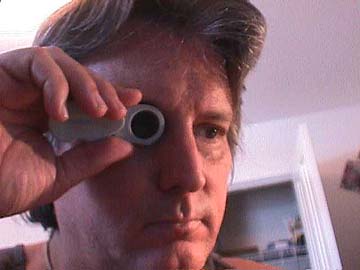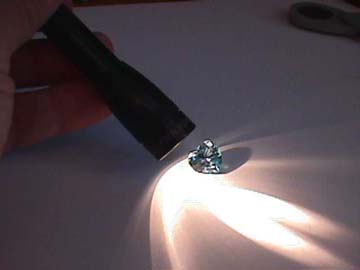The Study of the Chelsea Filter
The History of the Chelsea Filter
The Chelsea Filter is one of the most useful gemological tools you will find...and one of the least taught in many gemological schools in the United States. This filter was developed by two British gentlemen named Anderson and Payne of the British Gem Testing Laboratory and named for the place it was first used at Chelsea University.
The filter was first developed for the separation of natural emerald from green beryl. At the time only emeralds colored by chromium were considered to be true emeralds. The emeralds colored by vanadium were considered to be green beryls. Since the chromium-colored beryl would show the red color through the Chelsea filter and the vanadium would not, the filter was a diagnostic separations for natural emerald and natural green beryl.
How it works..
The Chelsea filter works by allowing only certain wavelengths of yellow-green and red colors to be transmitted through the filter. As a result, gemstones transmitting these colors will appear as either green or red, while other gemstones will simply appear dark. This allows, for instance, chromium-based emeralds to appear red since the red color is transmitted and the deeper green is not allowed to pass. (only the yellowish green). Likewise, in a green cobalt-coated topaz, the red of the cobalt is readily visible but the green color is not shown. Allowing a quick identification of a green stone as cobalt treated. The same applies to many other gemstones that can be viewed with a Chelsea filter. And while the Chelsea filter reaction can rarely be considered diagnostic, it is a very good indicator, and can quickly be used for diagnostic tests when used in conjunction with other gemological tools.
Before we start looking through a Chelsea filter, let us first learn HOW to use the Chelsea filter. Because proper use is just as important as having the tool to start with.
 How to hold it....
How to hold it....
You hold the Chelsea filter just as you would a jeweller’s loupe. Close to your eye. I see far too many people try to hold the Chelsea filter down close to the gemstone. This does not work and masks off your reaction. It is important to hold the Chelsea filter up to your eye as I am doing in the photographs to the left.
The Importance of Light
 The other big mistake that I see students make is not having enough direct and intense light on the gemstone. Some gemstones such as lapis lazuli have very faint reactions to the Chelsea filter. So, if you do not have your light right down on the stone....you may not see the reaction at all. And particularly if you are a new student, you will want to get the reactions as bright as possible until you learn what you are looking for.... Here is an example at left. Remember, hold that light right down on the stone...or the stone right up to the light source, to get your best reaction.
The other big mistake that I see students make is not having enough direct and intense light on the gemstone. Some gemstones such as lapis lazuli have very faint reactions to the Chelsea filter. So, if you do not have your light right down on the stone....you may not see the reaction at all. And particularly if you are a new student, you will want to get the reactions as bright as possible until you learn what you are looking for.... Here is an example at left. Remember, hold that light right down on the stone...or the stone right up to the light source, to get your best reaction.
OK, now let us look at some reactions. First, the stone that got it all started...the natural Colombian emerald. Below you will see at left a natural Colombian emerald crystal in matrix. (courtesy of Joe Kast Gemstones). Here you see a nice green Colombian emerald that is colored by chromium.


At right you see this same crystal through a Chelsea Filter. Notice the intense red color that is transmitted. This is not a color enhanced or doctored image. This is exactly as you would see a natural chromium colored emerald through a Chelsea filter.
Now let us look at a vanadium-colored emerald from Brazil. Notice the Brazilian stone at left below and see the reaction through the Chelsea filter at right. Virtually none. Compare the reactions to the images above. I think you can see the different reactions and why the Chelsea filter was developed to separate what were then considered to be real emeralds from green beryl. This perception, of course has since changed. See Emeralds in The Gemstones section for more on that topic.


There are other gemstones that a Chelsea filter can help identify. These include many synthetic and treated gemstones, as well as naturals. With many the reaction is so slight that it is very, very difficult to photograph. One is natural lapis lazuli. It will show a faint red reaction that is virtually impossible to photograph but can be seen fairly easily with a good light source. Another is jadeite, which will also show red in many specimens due to chromium as a coloring element. In fact, some people have taken the Chelsea filter and put it into another fancy holder and called it a Jadeite filter. But most are just Chelsea filters.
As you can see above, the Chelsea filter is one of the most useful tools for a variety of gemstones. With a Chelsea filter, a dichroscope, a spectroscope, and a 10x loupe, a good gemologist should be able to positively identify over 85% of the gemstones out there. It takes practice with known control stones so you will learn to see the various reactions and know what the Chelsea filter is telling you. But if you take some time to practice, it will serve you well on buying trips and field trips.
